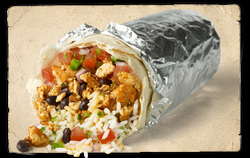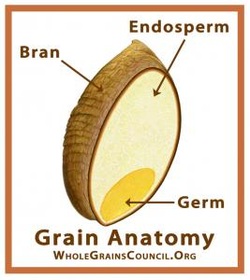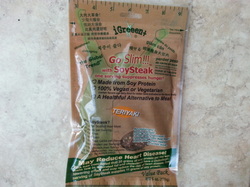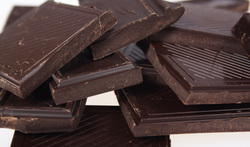|
If you've ever washed your fruits and veggies by rinsing them under running water, you know that it's easy to miss spots, especially with the leafy greens, which can remain gritty with dirt. Watch this video for a quick, easy way to thoroughly wash fruits and vegetables.
0 Comments
 This week the fast food restaurant chain Chipotle Mexican Grill just introduced a new plant-based option to their menu: Sofritas. According to Good Morning America, Sofritas are the first vegan meal offered by a national fast food chain that’s not a salad or a veggie burger. So, what exactly are Sofritas? Sofritas are a spicy, shredded, organic tofu dish that can be used in place of any of the meats in a salad, burrito, or tacos. According to the Chipotle website: “We start with organic tofu from Hodo Soy that they shred, then braise with chipotle chiles, roasted poblanos, and a blend of aromatic spices. The result is a delicious, spicy tofu that will give vegans and carnivores something they will both love”. When combined with brown rice, black beans, any or all of the fresh salsas, shredded lettuce, and guacamole, you have a tasty and satisfying plant-based meal that will keep you filled up for a long time! I was pleasantly surprised over this past weekend when I found Sofritas on the menu at a Chipotle in Southern California. Other than being a little too salty for my taste, the Sofritas were well seasoned and very flavorful. Sofritas are currently being tested at all Chipotle restaurants in California, Oregon, Washington, and Vancouver, B.C. If sales work out in the test markets, Chipotle eventually plans to roll out Sofritas at all of its restaurants. So if you’re looking for healthier, plant-based options, Chipotle just made it a little easier. Thanks Chipotle!  You hear about how whole grains are better for you all the time, and you feel good when you buy that whole grain bread, pasta, or wrap. But how do you know that what you’re buying really is whole grain? To answer that, let’s start with what makes a whole grain whole. A whole grain is the entire grain seed which contains all the essential parts along with the naturally-occurring nutrients, including the fiber. There are three key parts to the seed (also known as the kernel): the bran, the germ, and the endosperm. The bran is the protective shell, and is high in fiber and B vitamins. This is what gives whole grain foods their gritty, nutty texture. The germ is the seed for a new plant, and contains B vitamins, protein, minerals, and healthy oils. The endosperm is the starchy interior with protein and some vitamins and minerals. All of the fiber and most of the nutrients in whole grains are found in the bran and the germ.  I thought that beef jerky, or anything that even remotely resembled it in taste and/or texture was a thing of my past. That is, until today! I had a very interesting find at a 99 Ranch market, an Asian grocery chain: SoySteak by iGreen+. It’s made from soy protein, is 100% vegan, and a healthful alternative to meat, 60% lower sodium than meat, 86 calories per serving, 98% fat free, no cholesterol, 9 grams total carbs per serving, 11 grams protein per serving, contains isoflavones, and is non-GMO, according to the package. Sounds great, but how does it taste? Absolutely amazing! And the texture was so close to how I remember the texture of beef jerky that you would never know it’s soy, and I felt like shouldn’t be eating it! The best part: all the flavor without being salty and leaving me thirsty and weighted down with meat. It comes in several flavors, including Grilled, Teriyaki, Curry, Peppered, Hot, and Light. I tried the Teriyaki flavor and I can’t wait to try the others! So, if you enjoy meat and don’t want to eat animal products; if you love soy nutrients and don’t like the taste, this is for you! You can enjoy these as a snack or add it to your favorite dishes. Enjoy! Some of the many benefits of getting regular exercise include burning fat, weight loss, weight management, stress management, and better sleep. Did you know that regular exercise also helps us learn? According to John J Rately, MD, in his book “Spike”, exercise cues the building blocks of learning in the brain, and the real reason we feel so good when we get our blood pumping from exercise is that it makes our brain function at its best. In 2000, Scientists at Duke University Medical Center showed that exercise is as good as Zoloft for treating depression and exercise is better than Zoloft at keeping symptoms from returning after the depression is gone.
 Dark Chocolate! One of my absolute favorites!!! And I know I’m not alone! If you prefer milk chocolate, give dark chocolate a try and be patient, you will acquire a taste for it. I did, and milk chocolate has never tasted the same! Dark chocolate lovers, rejoice! Here are 7 healthy reasons to keep enjoying your dark chocolate!
Keep in mind that chocolate is high in fat, so don’t go too overboard eating dark chocolate. It’s best to limit yourself to about 1 ounce per day. I think I'll grab some right now! Everywhere you look, you’re being told you need antioxidants to fight free radicals. But what exactly are free radicals and what do free radicals do that’s so bad? Answering this question will require a little chemistry, just a little, because free radicals involve atoms, molecules, and unpaired electrons.
10 great foods that can help you keep your brain healthy:
Try adding these foods to your daily diet for your healthy brain! While your mother probably never told you to masticate your food, it’s likely that she did tell you to chew your food well before swallowing. And with very good reason.
Thoroughly chewing your food forces you to eat slowly and gives your body time to feel full. It gives your brain time to register that you have eaten enough food before you overeat. This is part of the reason why people who eat slowly are less likely to be overweight than people who eat fast. Thoroughly chewing your food makes it easier for your digestive system to completely digest the food that you eat. Digestion begins in your mouth with enzymes in your saliva (a-amylase and lipase) that digest carbohydrates and fats. The more you chew your food, the more of your food you expose to the enzymes and the more completely the food gets digested. More nutrients become available for absorption with more complete digestion. And as a result, your body absorbs more nutrients. Internal sensors in your gut tell your brain when you have enough nutrients and are satiated, which turns off your hunger signal. The more nutrients you can get out of your food, the less food you have to eat to feel satisfied. Research has shown that less ghrelin, a hormone responsible for feeling hunger, is released the more food is chewed, which makes you feel satisfied longer. High-fiber foods such as fruits, vegetables, nuts, and seeds force you to chew more and eat more slowly by the very nature of these foods. This is because your body cannot digest the fiber in these foods, so chewing is the only way your body can break down these high fiber foods and access their nutrients. How many times should you chew each bite of food? It’s not really necessary to count how many times you chew each bite because not all foods require the same number of chews to be chewed thoroughly. A good rule of thumb is to chew until you can no longer feel the texture of the food in your mouth. That’s when you know it’s time to swallow. I've been consciously trying to break my own bad habit of eating fast without properly chewing my food, and I’ll tell you, not only do my jaw muscles feel like they've been through a workout at the gym after every meal, it takes me significantly longer to eat my food! I find it very helpful to put my fork, spoon, or chop sticks down after every bite of food. When I don’t have the next bite loaded up and ready to go into my mouth, I don’t feel the need to rush and swallow without chewing properly. I also found that I was forced to take smaller bites because my normal bite had too much food to keep in my mouth long enough to properly chew before swallowing, and some of that excess food slipped down my throat only partially chewed. And I’ve noticed that by the time I’m half to three quarters of the way through a standard-sized meal that I normally consume, I’m already full! So if you’re trying to lose weight, this is a great way to control how much you eat without feeling hungry.  I’m going to use gravity as an analogy for diet. Gravity is the force that pulls us toward the earth and makes us go down when we fall. We get injured by gravity when we fall and hit the ground (or something on the ground) hard enough to damage our bodies. Falls can happen whether we’re low to the ground, high above the ground, or anywhere in-between. And we all know that the greater the distance of the fall, the greater the force of impact, and the greater the risk of injury or even possibly death. Whether you believe in gravity or not, if you fall out of a window from the 15th story of a building, you have a pretty good idea what’s going to happen. While it’s highly likely that you will be injured or even die from such a fall, you could land on something soft – maybe an awning that catches you on the 14th floor or a safety net further down. So why am I talking about gravity? Because I like to think of the risk of a fall and injury due to gravity as a great analogy to the risk of poor health and degenerative diseases due to diet and poor nutrition. Whether we choose to believe it or not, it doesn’t change the fact that we consistently see the same effects linked to the same causes over and over again. Just because you don’t believe you’re going to get injured or die if you jump out of a window doesn’t mean that it won’t happen. And just because you don’t believe you’re going to get a degenerative disease if you eat certain high-risk foods, including foods that you may not believe are high-risk, doesn’t mean that it won’t happen either. Using this analogy, choosing to eat a nutrient-dense, whole plant-based diet is like being on the ground in terms of risk. You’re safe, yet things could still go wrong. You could get a degenerative disease while eating a whole plant-based diet just as you could trip and get injured while walking on the ground. However, your risk is extremely low in both cases. On the other hand, choosing to eat a diet that’s essentially nothing but refined sugars, saturated fats, and cholesterol is similar to hanging out of a window on the 15th floor of a building in terms of risk. Both are very dangerous and your risk is extremely high in both cases (you’re essentially a heart attack waiting to happen, probably in both cases…). We make choices every day about things we do and things we put into our bodies. Sometimes we make higher-risk choices. If we manage the risk, it’s most likely going to be fine. Doing risky things adds spice to life! I’ve made some risky choices with respect to gravity. I love to jump from high points into water, which can be high risk. I manage the risk by making sure that the depth of the water is safe and that nothing is in the way. I once jumped out of an airplane, which can be extremely high risk. I managed the risk as best I could by jumping tandem with an expert and a parachute. I’m not saying you can never eat your favorite foods. What I am saying is that you can manage your risk to minimize the possibility of ever getting a chronic degenerative disease. A great way to do that is to create habits that incorporate mostly nutrient-dense whole plant-based foods into your diet while at the same time reducing your intake of refined sugars, saturated fat, and cholesterol whenever possible. Like having a parachute if you jump out of an airplane, it will dramatically lower your risk of ever being diagnosed with a degenerative disease, and allow you to occasionally enjoy some of your favorite, high-risk foods. |
Terri Quenzer, PhDTerri has a passion for good health and for helping others find happiness in themselves through better health! Through her scientific and life experiences, her goal is to help you reach your healthy goals!
Be The Healthy U!: nominated for San Diego's Best Nutrition/Cooking Classes of 2016!
Catch Terri's interview about plant-based nutrition on KCQB 1170 AM - click here.
How Not to Die: Terri interviews New York Times Bestselling Author Michael Greger, MD. Listen below.
Terri speaks with Jordan Hoffman of Jordan Hoffman Acupuncture about what to eat and East vs West.
Click Here To Sign Up For Your Free Newsletter
Archives
September 2017
Categories |


 RSS Feed
RSS Feed